All you need to know about the Egeskov Castle
Egeskov Castle is located in Denmark and, more precisely, on Denmark’s third largest Island, Fyn. The town where Egeskov Castle is found is Kværndrup, although the castle is much more famous than the town itself.
Also read: Best Museums in Copenhagen
A Brief History of Egeskov Castle
Egeskov Castle is the best preserved Renaissance castle in all of Europe, and although there are records of it dating back to the early 15th century, the current building dates back to 1544 and was commissioned by Frands Brockenhuus. It is characterized as being halfway between a castle and a fortress, due to the difficult political period of the time: a civil war known as Grevens fejde, that was caused by the introduction of the Protestant Reformation, and pushed most of the nobility to build houses that would allow them to find shelter from popular riots. The land on which Frands Brockenhuus built the castle belonged to the parents of his wife Anne Tinhuus, who had moved a few years before.
Also read: Man Meets the Sea - The giant statues of Esbjerg
In the following centuries, there were no big changes to the structure of the castle, which continued to be owned by various families of Danish nobility, until in 1784 it was sold to Henrik Bille, to whose family the castle still belongs.
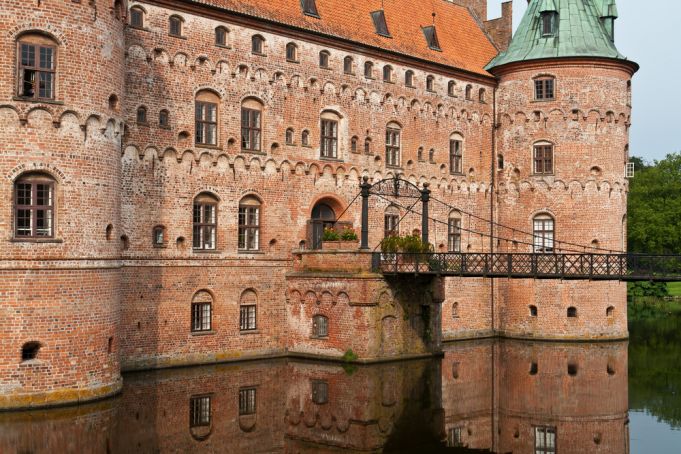
In 1883 a major renovation was carried out by the Swedish architect Helgo Zettervall at the behest of Julius Ahlefeldt-Laurvig-Bille. The roofs of the towers were raised and a new entrance gate was built, which is still used today to visit the castle. However, the project did not stop at the castle. In the same period, the structure was equipped with a farm, its own dairy facility, a power plant and even a small railway which allowed the castle to be self-sustaining and bring wealth to the territory.
The parks of the castle were already open to citizens and did not undergo major transformations until 1959, the year in which a substantial restoration of the historic grounds began. In the following years, a series of exhibitions were progressively opened, which can still be visited, inside the existing service buildings or within new ones built to house such exhibitions.
Also read: Visiting Helsingør and Kronborg Castle: what to see and what to do
The halls of the castle have been open to the public since 1986, and attract visitors looking to discover their beauty. It is also possible to stay overnight in one of the bedrooms that, during the day, is open to tourists.
Egeskov Castle has belonged to the Ahlefeldt-Laurvig-Bille family for 235 years, and they open it to the public as well as live in it.
Visit to the Park and Castle of Egeskov
A visit to Egeskov Castle, along with its park, will take about half a day, especially if you want to check out all the attractions it provides, including the labyrinth, wooden games and exhibitions that occupy an entire section of the park.
At the entrance to the castle you will be provided with a short leaflet in English that describes the contents of each room, so that you have a complete overview of what to see.
Also read: All you need to know about visiting the Louisiana Museum in Denmark
The park of the castle is one of the most surprising parts of the whole visit. It's a large space that is extremely well cared for, so much so that many Danes come here to spend an entire day with their families, as if it was amusement park. The attractions in the park of the Egeskov Castle are exciting for children as well. The park is divided into many different sections, each characterized by details that make it unique.
The park of Egeskov was designed by Niels Krag the Younger, between 1722 and 1740. As inspiration, the architect took the parks of the castle of Frederiksborg and also that of the palace of Versailles, a few kilometers from Paris. The various areas of the garden are separated by the water around the castle, but also by plants and hedges that reach heights of up to eight meters. Visiting this green space means retracing almost three centuries of history that, with the necessary modernizations, have come down to us. The park was reopened to the public after a substantial renovation in 1962 and since then it has been a valuable aid to the tourism sector of the entire southern part of the island of Fyn.
Here are the parts of the park that we consider to be the most beautiful, starting with the castle.
The Castle, Titania's palace and the Shop
Egeskov Castle is built within a small lake that reaches a maximum depth of 5 meters. The structure is supported by oak poles, and legend has it that it took an entire forest of oaks to build its foundations. The name Egeskov, in Danish, means "forest of oaks".
Also read: Shopping in Copenhagen: Where to Go and What to Buy
Its nearly two thousand windows are not the only amazing thing about the castle. Another detail not to be overlooked, linked to its nature as a fortress, is the technique with which it was built. In fact, the castle consists of two long buildings connected by a thick double wall, so that the first building could be conquered, while life went quietly on in the other. The stairs are hidden inside the double wall, more than a meter wide, and even a well, to able to ensure the water supply during a possible siege.
The outer walls of the castle have several cracks, through which boiling liquids could be launched on the enemy who was at the foot of the castle. To make the castle even safer it was only accessible through a drawbridge.
You can see all the rooms of the Egeskov castle open to the public in about an hour. The castle is built on three floors with the attic at the top.
The Ground floor and the Hunting Hall
There are two rooms open to visitors on the ground floor of Egeskov Castle. The first is probably one of the most famous of the whole castle: the Hunting Hall. It is impossible to get confused about where you are. In fact, this room has a large series of hunting trophies hanging on the walls, as well as animal skins, such as that of a lion, fully on display. There is also no shortage of weapons, such as spears hanging on the right wall. The stuffed heads almost overshadow the decor of the hunting room. This room was used by Count Gregers Ahlefeldt-Laurving-Bille, who lived from 1905 to 1985, as his personal study, and the animals on the walls are macabre souvenirs of his travels between 1930 and 1950. Mostly from Africa, these animals also earned him awards, such as the one for the extraordinary length (90 cm) of the horns of the ampala he managed to kill. A record that has not yet been broken.
Also read: Cycling holiday in Denmark: the island of Funen
From the hunting room, you ca enter the Yellow Room, characterized by a late baroque style. Here the environment is decidedly more discreet. This room dates back to the first half of the 18th century, as evidenced by the expensive Louis XVI style furniture. Most of the items visible here were gifts for Jessie Bille-Brahe received at her wedding in 1875. This room has a special chandelier filled with candles, because no electricity reaches here and these are lit when the room is used in the evening. Also peculiar is the Viennese clock featuring a small musical organ contained within its frame. The doors leading to the room are embellished with gold leaf covering.
The First Floor and the Palace of Titania
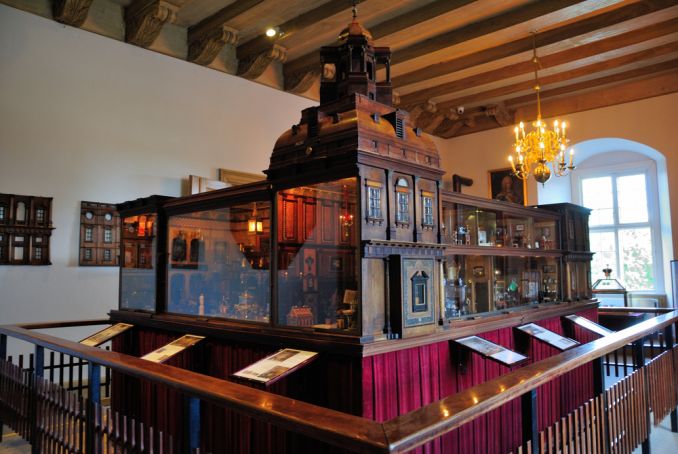
The second floor of Egeskov Castle can be visited in its entirety except for one room. The entire floor was formerly used as a granary, before Countess Nonni restored it to its former glory in 1975. The largest room is the Banquet Hall. The left side of the Banquet Hall is decorated with large canvases that reproduce the portraits of Admiral Niels Juel and his wife Margrethe Ulfeldt, completed by the court painter of King Frederick IV. The peculiarity of these paintings is that, looking at them, it can seem that their eyes follow you around the room, as well as the tip of their shoes.
Also read: 85 meter high artificial wall built in Denmark for climbing
Through the deer corridor, you can peek in on the virgin's cell and the captain's room, two small rooms used for guests who wish to stay overnight here. The deer corridor once again recalls the sport of hunting loved by the counts. The hunting trophies belonged to Count Gregers, who hung them on the wall along with the arrows he used.
Another important room of Egeskov Castle is the one where Titania's palace is housed. This is a huge dollhouse, for which construction was completed in 1922. The work, made entirely of wood, is by the English painter Sir Neville Wilkinson, who created it for his daughter Guendolen who requested a house for the little elves who lived in her garden. The palace of Titania required fifteen years of work and the help of some Irish craftsmen. In the rooms visible on the four long sides of the dollhouse you can count over three thousand pieces and objects from all over the world, which only increase the value of this work, owned by Lego that has lent it to the castle.
The saddest love story of the whole castle was staged in the room of the dollhouse and the adjacent turret. It was here that a noble lady- in- waiting Maid Rigborg (who lived between the 16th and 17th centuries) was caught by her father in compromising circumstances with a man. Her father decided to lock her in the nearby tower for the rest of her life, but her mother petitioned King Christian IV to free her. The King accepted the request, and Maid Rigborg spent the rest of her life in an estate in the center of the island of Fyn.
Also read: Up to date news in Denmark
The visit to this floor continues through the remaining rooms, including the Victorian Room, the Music Room with a piano, the Butler's Room, now used to accommodate tourists staying overnight, Countess Jessie's room, decorated with numerous historical paintings and the South Tower formerly used by Count Michael when he visited his parents and is currently used for castle guests. Ph: Nina Alizada / Shutterstock.com
The Attic and the Wooden Man
The final part of the visit to Egeskov Castle is the attic. A warm space characterized by the beams that support the roof structure. These load-bearing beams, also made of oak, give a clear idea of how much wood was used in the building of the castle. The entire attic showcases a collection of historical toys from the 19th century, alongside an exhibition of household utensils that span several generations, from collections of porcelain to glassware, passing through molds for jelly and ice cream.
Also read: The Faroe Islands in spring
The most important piece kept inside the attic of the Egeskov castle, however, is the wooden man, linked to a terrible legend. If the statuette were to be removed from its cushion, positioned just below the roof beams, it would cause the collapse of the castle into the pond on Christmas night. Frightened by this prophecy, the previous families who lived in the castle refused to celebrate Christmas here. The present owner, however, celebrates Christmas here, dining in the banquet hall, but prepares a bowl of rice pudding for the wooden man.
The Shop
The castle shop is located in a detached building, just beyond the pond. It offers refreshments, like a nice ice cream cone, and you can buy souvenirs. The top floor also has an exhibition on fashion in the second half of the nineteenth century.
The Rose Garden
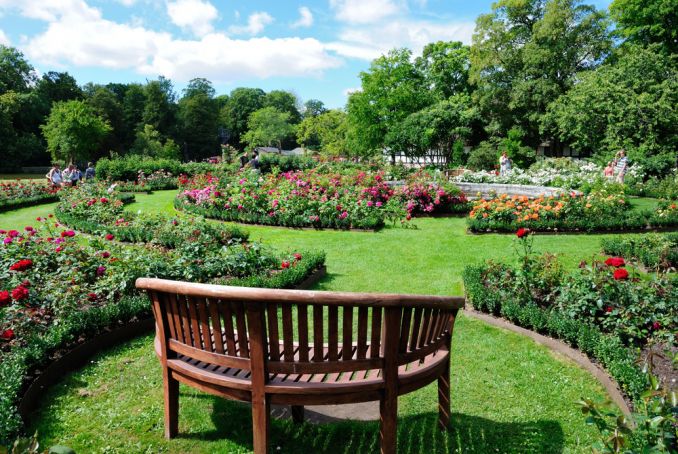
Begin your tour of the Egeskov Castle park from the Rose Garden, which is located right in front of the castle, practically to the left of the shop building, surrounded by a bend in the pond. It was reopened in 2004, designed by Egeskov Castle's head gardener Peter Bonde Poulsen.
The long rows of roses are surrounded by a low hedge border. Within the border there are many different types of roses. In fact, according to the garden guide, it seems that here there are all the existing varieties of roses: from wandering roses, to historical varieties, from roses with huge flowers, to those that extend like a carpet, from English roses to many other types. It is said that there are about one hundred different varieties that bloom from mid-June until they reach their peak in mid-July. Ph: Nina Alizada / Shutterstock.com
The Sculptures
The gardens are dotted with sculptures, adding to the numerous attractions of Egeskov Castle park. Municipalities and companies alike look to the sculpture in the gardens for inspiration.
The sculptures are by many different artists and are all for sale, so something strikes you... you might as well take it home! For this reason, the sculptures on display ARE constantly changing, and there are always about about fifty pieces scattered throughout the park. The decision of what to exhibit is the result of a close collaboration between Count Michael Ahlefeldt and the Galleri5000 gallery, which then handles the sale of the works.
The Renaissance Garden
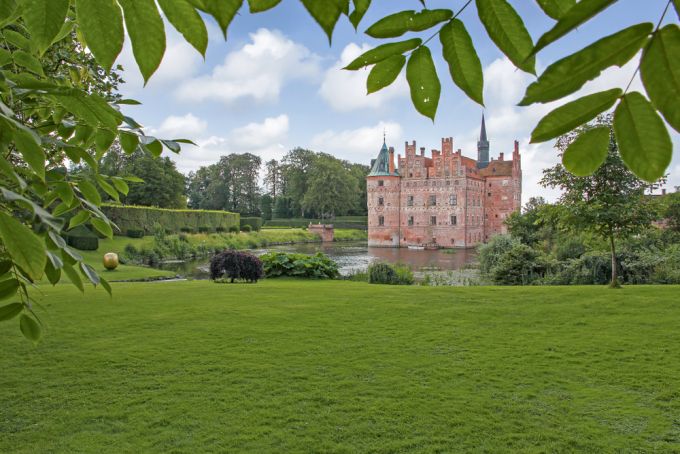
On the opposite side of the castle from the rose garden lies the Renaissance Garden. It has a strong impact and is joined to the castle itself through the disused drawbridge. The current layout of the garden dates back to a 1962 makeover by French gardener Ferdinan Duprat.
This space respects the classic canons of the Renaissance and has a central axis along which there are fountains, colored gravel that defines the design of the garden, boxwood trees cut into varied shapes such as pyramids, spirals and even squirrels. Ph: Nick Brundle / Shutterstock.com
The Resting Garden
The resting garden, despite its proximity to the castle, is a bit hidden. In fact, it is covered by the high hedges that shelter it. To reach it, continue beyond the castle, skirting the small lake that remains on the left. Secluded and secret, the peaceful garden welcomes visitors who want to take a break during their visit to the Egeskov castle and its big park, maybe a little bit apart from the shouts of children having fun in the playground.
Here you can stop and rest, perhaps in one of the hammocks in the shade of the beech trees.
Eighteenth-century labyrinth
Unfortunately, the eighteenth-century labyrinth is not accessible. It is also known as the old labyrinth, to distinguish it from the new (open) one in the play area. Positioned immediately to the right of the resting garden, you can't miss it, thanks to its classic intricate paths.
Its shape dates back to the 19th century, when it was designed to amuse and entertain the family that resided in the castle. The closure was due to the desire to maintain the space: the fragile roots of the hedges would not hold up to the constant passage of visitors, which would compromise the roots and consequently the old maze itself.
The English Garden
Crossing the pond, you will reach the left bank. Here, before returning to the rose garden, you will come across the English garden.
The English garden is characterized by a beautiful park and old trees under which you can stop and enjoy some shade, including a very large plane tree and a weeping willow.
The English garden is particularly popular with the Danes, who never miss a chance to stop here for a picnic during their visits to Egeskov Castle.
Exhibition on Man and Machines
The first of the exhibitions on display at Egeskov Castle is the one dedicated to man and machines, with pieces ranging from 1860 to 1910. The entire exhibition is housed inside a large white building with red doors and a thatched roof. Here you can see numerous dresses and uniforms, worn by mannequins and flanked by the first means of transport. Such as carriages that were pulled by horses, cars and mopeds with the first mechanical technologies, as well as agricultural tools, bicycles and the first motorcycles.
Exhibition on Historic Automobiles and Airplanes
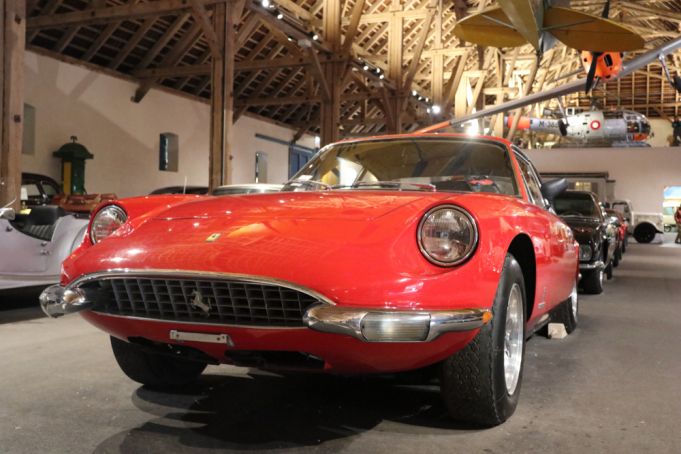
Larger than the previous exhibit is the exceptional Historic Automobiles and Airplanes exhibit. This exhibit was founded in 1967 and features an extraordinary collection of airplanes and motor vehicles. The two planes descending from the ceiling leave an impression upon entering the space.
Also read: Denmark apologizes to Inuit children
The flying vehicles featured here, on the ground and attached to the ceiling, consist of eight airplanes and one helicopter, spanning a period of some fifty years. On the ground you can see the collection of classic cars, about fifty of them, ranging from the 1980s to early pieces from the late 19th century. The oldest piece is a steam-powered vehicle from 1899, still in working order. Ph: Egeskov Castle is the best preserved Renaissance castle in all of Europe
The Turret and the Playground
Leaving the exhibition area, which is divided into several buildings that are partly connected, return to the green. First of all, you will come across Piet Heins' labyrinth, which is open to the public. Despite the fact that this type of activity is aimed at children, don't shy away from it and, as in all labyrinths (for example, the one at Schönbrunn Palace in Vienna), get lost on the quest to find the raised structure that overlooks the entire route, and that lets you down via a slide.
Once out of here, dedicate yourself to the games in the activity area, and play old wooden games of the past: from the stilts you might have already tried at Hamlet's castle (insert link? to other article?), to carts or an interpretation of bowling.
Play Area and Recreational Activities
A few steps away from the small playground is a much larger one with a trampoline and climbing ropes, a bit further away from the castle and in the direction of the exit. You can get to it through the Tree Top Walking Path, a path of nets and walkways in the trees, which vaguely resembles an adventure park and allows you to enjoy an elevated view of the whole park.
The Garden of Life
One of the most particular gardens of the Egeskov Castle is the Garden of Life, located just after the entrance and near the playground.
The Garden of Life, through its circular structure, its fountains and its installations, symbolizes the passage of time, the rhythm of the seasons and stimulates the senses. At the exact center of the Garden of Life is the sundial of Piet Hein, a Danish mathematician, inventor and scientist.
Also read: The Eysturoy tunnel opens in Denmark
At the heart of the design of this garden is, undoubtedly, the idea to instill a sense of peace in visitors, while at the same time tickling their senses, through shapes, smells, colors and scents on a journey through the seasons of time.
The Garden of Life is divided into sections, each of which, through a combination of colors, represents a different season. The element of water is important in each of them and is integrated through fountains in all sections.
The Kitchen Garden
Before ending a tour of the Egeskov castle, you can reach the kitchen garden. The kitchen garden is quite recent, in fact it was created in 1972 at the request of Countess Nonni Ahlefeldt, based on an original idea of hers. It is inspired by the kitchen gardens made popular in the seventeenth century during the reign of Christian IV.
Also read: Top International schools in Copenhagen
The entire garden is conceived as an alternation of raised spaces and arches, and a huge variety of vegetables and edible flowers can be found here. All the plants are produced by Egeskov's in-house green market, which also offers them for sale. This is the only company of its kind that can be traced back to Danish nobility.
The kitchen garden satisfies the needs of the family that owns Egeskov, with vegetables, to herbs that allow them to continually enjoy fresh produce. Farm to table indeed!
Egeskov Castle Prices and Timetable
The average visit to Egeskov Castle takes about three and a half hours, that is if you don’t fall asleep in a hammock or under a tree. It has to be said, seeing all those rooms and the exhibitions can be tiring.
The opening hours of the castle vary during the year:
- Between the end of April and the end of June, and in September and October, the park opens at 10:00 am and closes at 5:00 pm, with the castle opening an hour later.
- - Between July and the beginning of August, the park opens at 10:00 am and closes at 7:00 pm. In this case the opening of the castle coincides with that of the park
- From the 12th of August until the end of the month the park opens at 10:00 am and closes at 6:00 pm. The castle opens one hour later than the park.
- On some days of the year you can also visit in the evening.
Entrance fees for Egeskov Castle and its park vary throughout the year:
- For the period between June 22 and September 1, the entrance to the park and the exhibitions, is about 26€ for adults and 15€ for children from 4 to 12 years old, free for under 4.
If instead you want to visit the castle too, the cost goes up to about 30€ for adults and 18€ for children. It is not possible to buy a ticket only for access to the castle.
- - During the remaining opening days of the year, there is a single combined ticket, which allows access to the park, exhibitions and castle, and costs about 26€ for adults and 15€ for children.
Updated information about opening hours and entrance costs are available at the dedicated page on the official website.
General Info
View on Map
All you need to know about the Egeskov Castle
Egeskov Gade 18, 5772 Kværndrup, Denmark





















